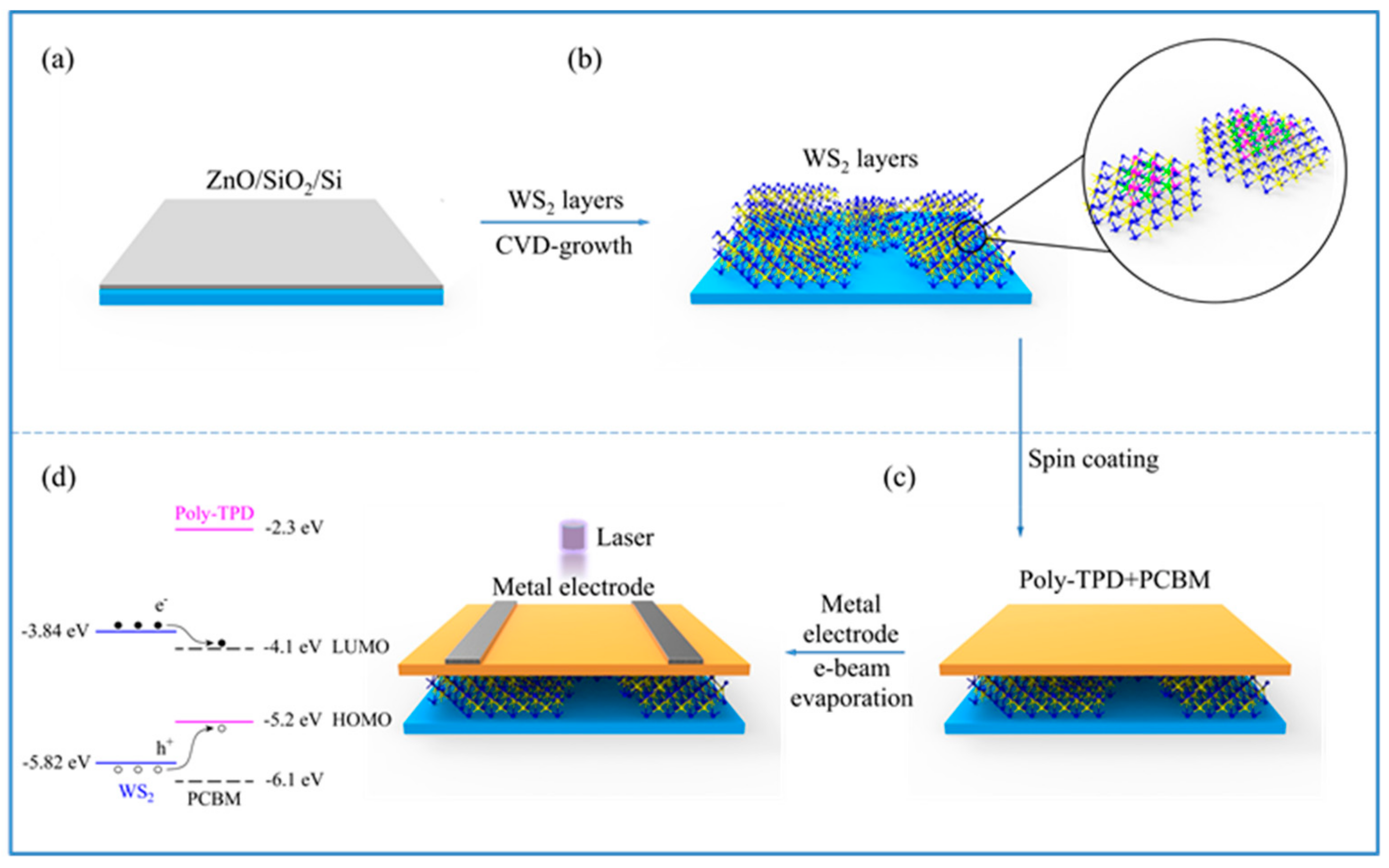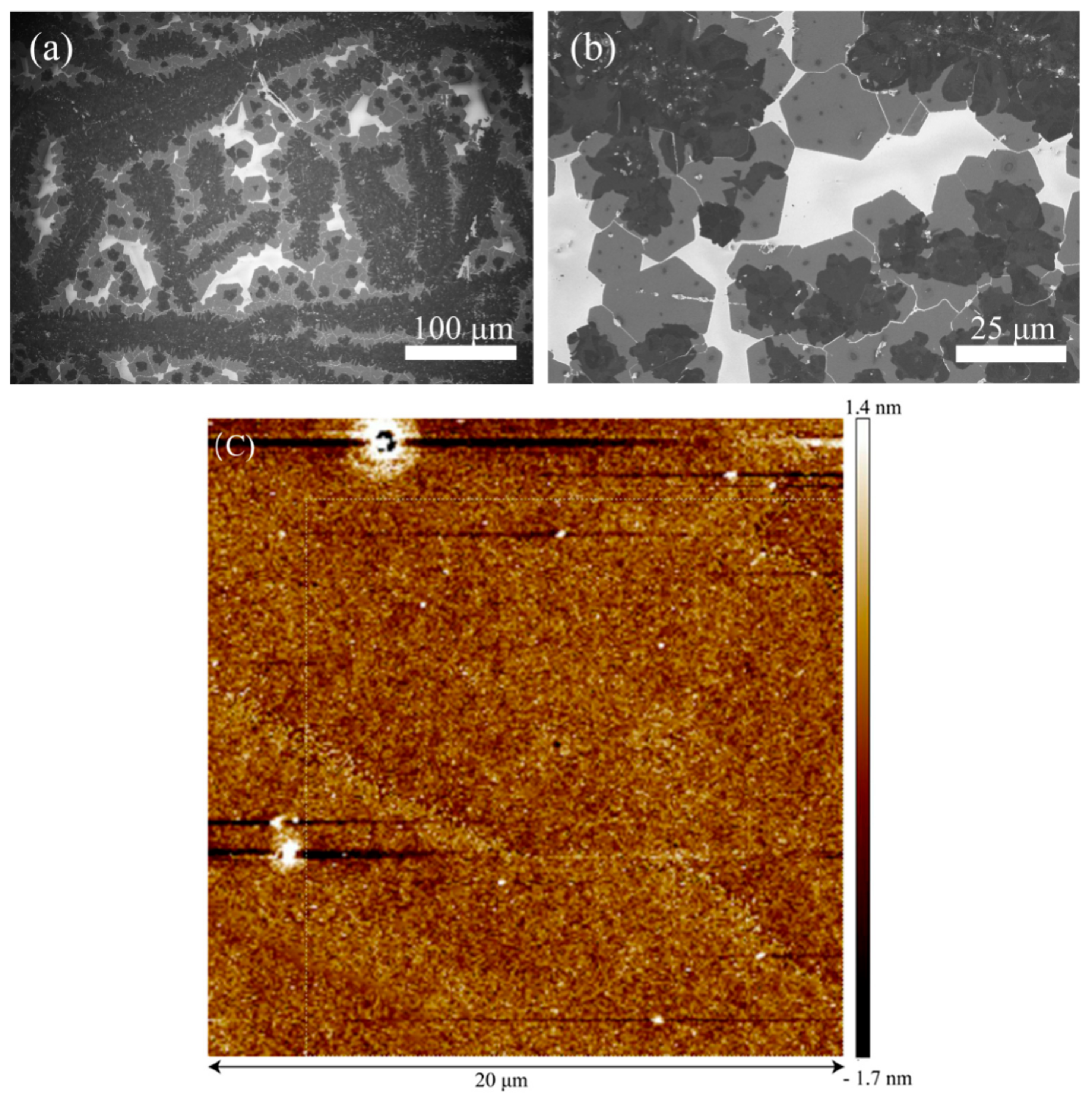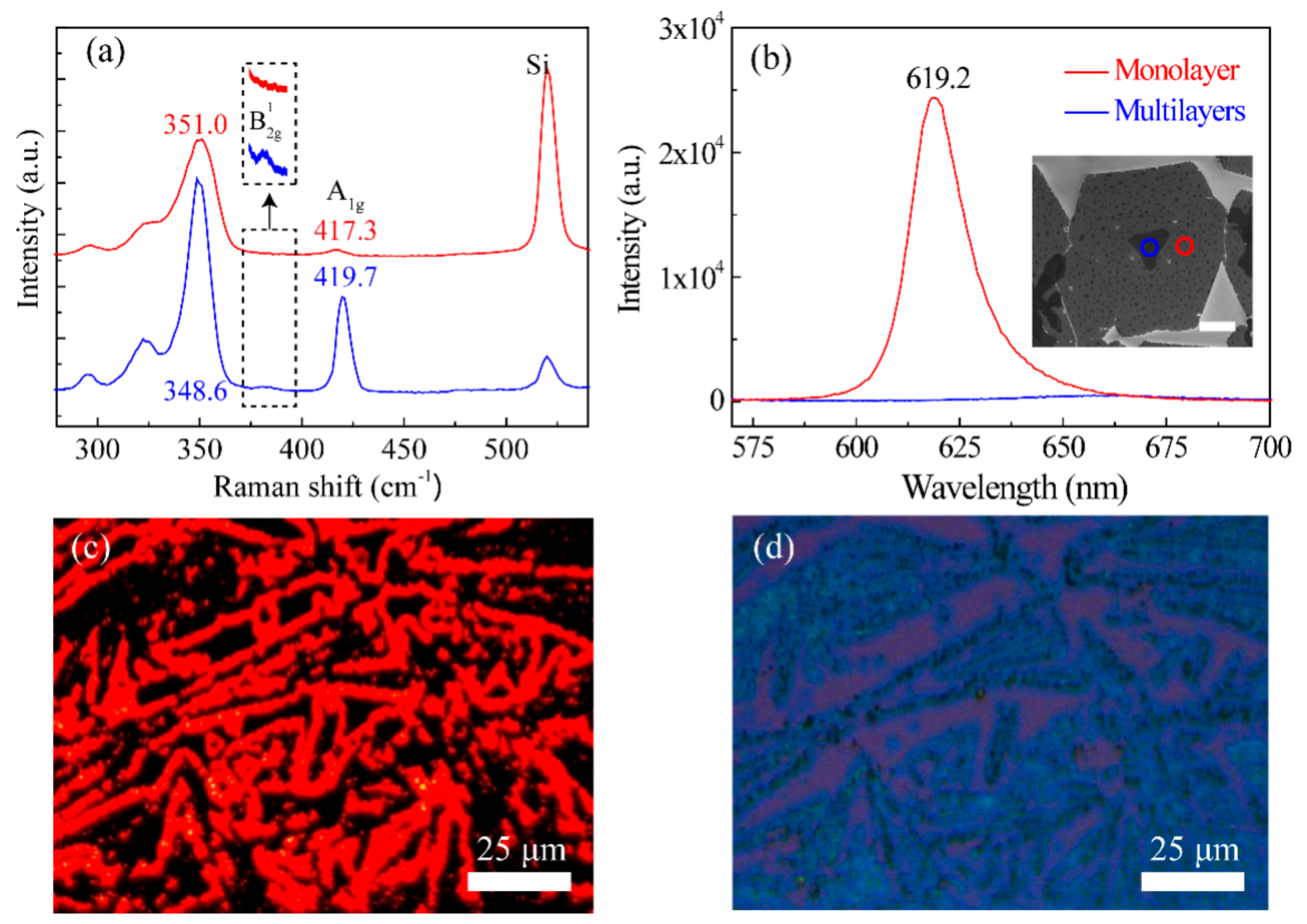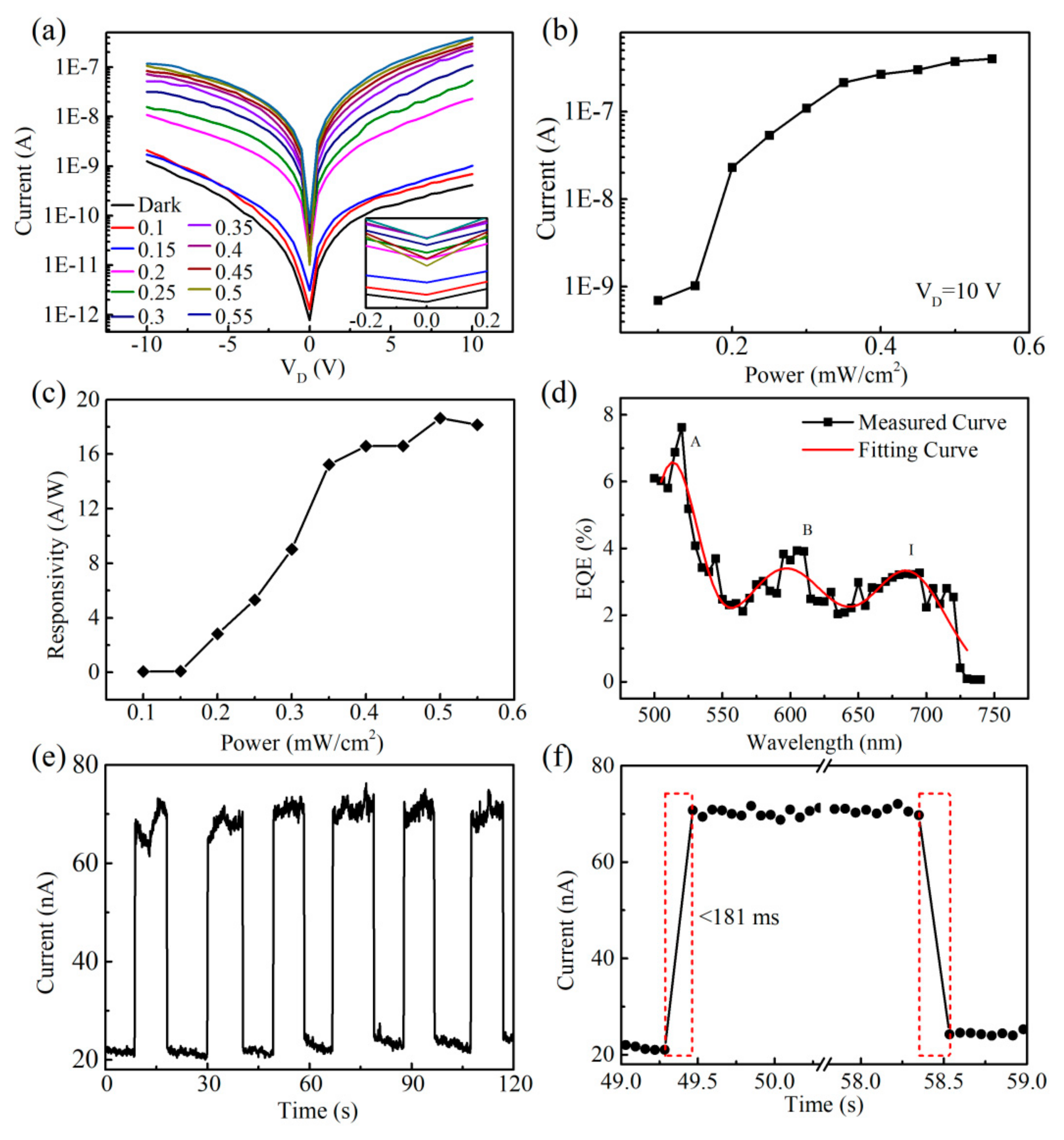A Bilayer 2D-WS2/Organic-Based Heterojunction for High-Performance Photodetectors
Abstract
:1. Introduction
2. Materials and Methods
Fabrication and Characterizations
3. Results and Discussion
Opto-Electronic Properties of Photodetector
4. Conclusions
Author Contributions
Funding
Conflicts of Interest
References
- Zhao, S.; Surwade, S.P.; Li, Z.; Liu, H. Photochemical oxidation of CVD-grown single layer graphene. Nanotechnology 2012, 23, 355703. [Google Scholar] [CrossRef] [PubMed]
- Zhao, S.; Zhou, F.; Li, Z.; Liu, H. Effect of precursor purity and flow rate on the CVD growth of hexagonal boron nitride. J. Alloy. Compd. 2016, 688, 1006–1012. [Google Scholar] [CrossRef]
- Lv, R.; Robinson, J.A.; Schaak, R.E.; Sun, D.; Sun, Y.; Mallouk, T.E.; Terrones, M. Correction to transition metal dichalcogenides and beyond: Synthesis, properties, and applications of single- and few-layer nanosheets. Acc. Chem. Res. 2015, 48, 56–64. [Google Scholar] [CrossRef] [PubMed]
- Xie, Z.; Wang, D.; Fan, T.; Xing, C.; Li, Z.; Tao, W.; Liu, L.; Bao, S.; Fan, D.; Zhang, H. Black phosphorus analogue tin sulfide nanosheets: Synthesis and application as near-infrared photothermal agents and drug delivery platforms for cancer therapy. J. Mater. Chem. B 2018, 6, 4747–4755. [Google Scholar] [CrossRef]
- Fan, T.; Zhou, Y.; Qiu, M.; Zhang, H. Black phosphorus: A novel nanoplatform with potential in the field of bio-photonic nanomedicine. J. Innov. Opt. Heal. Sci. 2018, 11, 1830003. [Google Scholar] [CrossRef] [Green Version]
- Guo, Z.; Chen, S.; Wang, Z.; Yang, Z.; Liu, F.; Xu, Y.; Wang, J.; Yi, Y.; Zhang, H.; Liao, L.; et al. Metal-Ion-Modified Black Phosphorus with Enhanced Stability and Transistor Performance. Adv. Mater. 2017, 29, 1703811. [Google Scholar] [CrossRef]
- Xing, C.; Huang, W.; Xie, Z.; Zhao, J.; Ma, D.; Fan, T.; Liang, W.; Ge, Y.; Dong, B.; Li, J.; et al. Ultrasmall Bismuth Quantum Dots: Facile Liquid-Phase Exfoliation, Characterization, and Application in High-Performance UV-Vis Photodetector. ACS Photonics 2018, 5, 621–629. [Google Scholar] [CrossRef]
- Fan, T.; Xie, Z.; Huang, W.; Li, Z.; Zhang, H. Two-dimensional non-layered selenium nanoflakes: Facile fabrications and applications for self-powered photo-detector. Nanotechnology 2019, 30, 114002. [Google Scholar] [CrossRef]
- Luo, M.; Fan, T.; Zhou, Y.; Zhang, H.; Mei, L. 2D Black Phosphorus-Based Biomedical Applications. Adv. Funct. Mater. 2019, 29, 1808306. [Google Scholar] [CrossRef]
- Wang, H.-D.; Sang, D.K.; Guo, Z.-N.; Cao, R.; Zhao, J.-L.; Shah, M.N.U.; Fan, T.-J.; Fan, D.-Y.; Zhang, H. Black phosphorus-based field effect transistor devices for Ag ions detection. Chin. Phys. B 2018, 27, 087308. [Google Scholar] [CrossRef]
- Huang, W.; Xie, Z.; Fan, T.; Li, J.; Wang, Y.; Wu, L.; Ma, D.; Li, Z.; Ge, Y.; Huang, Z.N.; et al. Black-phosphorus-analogue tin monosulfide: An emerging optoelectronic two-dimensional material for high-performance photodetection with improved stability under ambient/harsh conditions. J. Mater. Chem. C 2018, 6, 9582–9593. [Google Scholar] [CrossRef]
- Cao, R.; Wang, H.D.; Guo, Z.N.; Sang, D.K.; Zhang, L.Y.; Xiao, Q.L.; Zhang, Y.P.; Fan, D.Y.; Li, J.Q.; Zhang, H. Black Phosphorous Photodetectors: Black Phosphorous/Indium Selenide Photoconductive Detector for Visible and Near Infrared Light with High Sensitivity. Adv. Opt. Mater. 2019, 7, 1970047. [Google Scholar] [CrossRef]
- Li, N.; Feng, L.P.; Su, J.; Zeng, W.; Liu, Z.T. Optical and electrical properties of Al:WS2 films prepared by atomic layer deposition and vulcanization. RSC Adv. 2016, 6, 64879–64884. [Google Scholar] [CrossRef]
- Park, J.; Kim, M.S.; Cha, E.; Kim, J.; Choi, W. Synthesis of uniform single layer WS2 for tunable photoluminescence. Sci. Rep. 2017, 7, 16121. [Google Scholar] [CrossRef] [PubMed]
- Zhu, B.; Chen, X.; Cui, X. Exciton Binding Energy of Monolayer WS2. Sci. Rep. 2015, 5, 9218. [Google Scholar] [CrossRef] [PubMed]
- Chernikov, A.; Berkelbach, T.C.; Hill, H.M.; Rigosi, A.; Li, Y.; Aslan, O.B.; Reichman, D.R.; Hybertsen, M.S.; Heinz, T.F. Exciton Binding Energy and Nonhydrogenic Rydberg Series in MonolayerWS2. Phys. Rev. Lett. 2014, 113, 076802. [Google Scholar] [CrossRef] [PubMed]
- Kotadiya, N.B.; Lü, H.; Mondal, A.; Ie, Y.; Andrienko, D.; Blom, P.W.M.; Wetzelaer, G.-J.A. Universal strategy for Ohmic hole injection into organic semiconductors with high ionization energies. Nat. Mater. 2018, 17, 329. [Google Scholar] [CrossRef] [PubMed]
- Li, D.; Lai, W.-Y.; Zhang, Y.-Z.; Huang, W. Printable Transparent Conductive Films for Flexible Electronics. Adv. Mater. 2018, 30, 1704738. [Google Scholar] [CrossRef] [PubMed]
- Yang, M.; Wang, J.; Zhao, Y.; He, L.; Ji, C.; Liu, X.; Zhou, H.; Wu, Z.; Wang, X.; Jiang, Y. Three-dimensional topological Insulator Bi2Te3/organic thin film heterojunction photodetector with fast and wideband response from 450 to 3500 Nanometers. ACS Nano 2019, 13, 755–763. [Google Scholar] [CrossRef] [PubMed]
- Zhang, H.; Song, L.; Luo, L.; Liu, L.; Wang, H. TiO2/Sb2S3/P3HT Based Inorganic-Organic Hybrid Heterojunction Solar Cells with Enhanced Photoelectric Conversion Performance. J. Electron. Mater. 2017, 46, 4670–4675. [Google Scholar] [CrossRef]
- Trzcinski, K.; Szkoda, M.; Siuzdak, K.; Sawczak, M.; Lisowska-Oleksiak, A. Enhanced photoelectrochemical performance of inorganic-organic hybrid consisting of BiVO4 and PEDOT:PSS. Appl. Surf. Sci. 2016, 388, 753–761. [Google Scholar] [CrossRef]
- Dai, X.; Shi, C.; Zhang, Y.; Wu, N. Hydrolysis preparation of the compact TiO2 layer using metastable TiCl4 isopropanol/water solution for inorganic-organic hybrid heterojunction perovskite solar cells. J. Semicond. 2015, 36, 7. [Google Scholar] [CrossRef]
- Lv, Y.; Huang, F.; Zhang, L.; Weng, J.; Zhao, S.; Ji, Z. Preparation and Photoluminescence of Tungsten Disulfide Monolayer. Coatings 2018, 8, 205. [Google Scholar] [CrossRef]
- Gutiérrez, H.R.; Perea-López, N.; Elías, A.L.; Berkdemir, A.; Wang, B.; Lv, R.; López-Urías, F.; Crespi, V.H.; Terrones, H.; Terrones, M. Extraordinary Room-Temperature Photoluminescence in Triangular WS2 Monolayers. Nano Lett. 2013, 13, 3447–3454. [Google Scholar] [CrossRef] [PubMed]
- Liu, P.; Luo, T.; Xing, J.; Xu, H.; Hao, H.; Liu, H.; Dong, J. Large-Area WS2 Film with Big Single Domains Grown by Chemical Vapor Deposition. Nanoscale Res. Lett. 2017, 12, 558. [Google Scholar] [CrossRef] [PubMed]
- Peimyoo, N.; Shang, J.; Cong, C.; Shen, X.; Wu, X.; Yeow, E.K.L.; Yu, T. Nonblinking, Intense Two-Dimensional Light Emitter: Monolayer WS2 Triangles. ACS Nano 2013, 7, 10985–10994. [Google Scholar] [CrossRef]
- Lan, F.; Yang, R.; Xu, Y.; Qian, S.; Zhang, S.; Cheng, H.; Zhang, Y. Synthesis of Large-Scale Single-Crystalline Monolayer WS2 Using a Semi-Sealed Method. Nanomaterials 2018, 8, 100. [Google Scholar] [CrossRef] [PubMed]
- Chan, K.H.; Ng, S.M.; Wong, H.F.; Leung, C.W.; Mak, C.L. Rectify effect of Pedot:PSS/WS2 heterostructure. Phys. Status Solidi A 2019, 216, 1800829. [Google Scholar] [CrossRef]
- Yan, J.; Hao, Y.; Cui, Y.; Zhang, J.; Zou, Y.; Zhang, W.; Yu, G.; Zheng, J.; Xu, W.; Zhu, D. Ambipolar charge transport in an organic/inorganic van der Waals p-n heterojunction. J. Mater. Chem. C 2018, 6, 12976–12980. [Google Scholar] [CrossRef]
- Shen, Y.; Yu, D.; Wang, X.; Huo, C.; Wu, Y.; Zhu, Z.; Zeng, H. Two-dimensional CsPbBr3/PCBM heterojunctions for sensitive, fast and flexible photodetectors boosted by charge transfer. Nanotechnology 2018, 29, 085201. [Google Scholar] [CrossRef]
- Homan, S.B.; Sangwan, V.K.; Balla, I.; Bergeron, H.; Weiss, E.A.; Hersam, M.C. Ultrafast Exciton Dissociation and Long-Lived Charge Separation in a Photovoltaic Pentacene MoS2 van der Waals Heterojunction. Nano Lett. 2017, 17, 164–169. [Google Scholar] [CrossRef] [PubMed]
- Yao, D.; Zhang, C.; Zhang, S.; Yang, D.A.; Eric, W.; Yu, X.; Wilson Gregory, J.; Wang, H. 2D-3D mixed organic-inorganic perovskite layers for solar cells with enhanced efficiency and stability induced by n-Propylammonium iodide additives. ACS Appl. Mater. Interfaces 2019, 11, 29753–29764. [Google Scholar] [CrossRef] [PubMed]
- Li, Y.; Shu, J.; Huang, Q.; Chiranjeevulu, K.; Kumar, P.N.; Wang, G.E.; Deng, W.H.; Tang, D.; Xu, G. 2D metal chalcogenides with surfaces fully covered with an organic “promoter” for high-performance biomimetic catalysis. Chem. Commun. 2019, 55, 10444–10447. [Google Scholar] [CrossRef]
- Ba, Q.; Jana, A.; Wang, L.; Kim, K.S. Dual emission of water-stable 2D organic-inorganic halide perovskites with Mn(II) dopant. Adv. Funct. Mater. 2019, 8, 1904768. [Google Scholar] [CrossRef]
- Chiang, C.-H.; Wu, C.-G. Bulk heterojunction perovskite-PCBM solar cells with high fill factor. Nat. Photonics 2016, 10, 196–200. [Google Scholar] [CrossRef]
- Wang, X.; Wang, J.Y.; Zhao, H.M.; Jin, H.; Yu, J.S. Detectivity enhancement of double-layer organic photodetectors consisting of solution-processed interconnecting layers. Mater. Lett. 2019, 243, 81–83. [Google Scholar] [CrossRef]
- Blankenburg, L.; Sensfuss, S.; Schache HMarten, J.; Milker, R.; Schrodner, M. TPD wide-bandgap polymers for solar cell application and their sensitization with small molecule dyes. Synth. Met. 2015, 199, 93–104. [Google Scholar] [CrossRef]
- Yang, X.; Divayana, Y.; Zhao, D.; Leck, K.S.; Lu, F.; Tan, S.T.; Abiyasa, A.P.; Zhao, Y.; Demir, H.V.; Sun, X.W. A bright cadmium-free, hybrid organic/quantum dot white light-emitting diode. Appl. Phys. Lett. 2012, 101, 233110. [Google Scholar] [CrossRef]
- Kang, J.; Tongay, S.; Zhou, J.; Li, J.B.; Wu, J.Q. Band offsets and heterostructures of two-dimensional semiconductors. Appl. Phys. Lett. 2013, 102, 012111. [Google Scholar] [CrossRef]
- Muhlbacher, D.; Scharber, M.; Morana, M.; Zhu, Z.G.; Waller, D.; Gaudiana, R.; Brabec, C. High photovoltaic performance of a low-bandgap polymer. Adv. Mater. 2006, 18, 2884–2889. [Google Scholar] [CrossRef]
- Raja, A.; Selig, M.; Berghauser, G.; Yu, J.; Hill, H.M.; Rigosi, A.F.; Brus, L.E.; Knorr, A.; Heinz, T.F.; Malic, E.; et al. Enhancement of exciton-phonon scattering from monolayer to bilayer WS2. Nano Lett. 2018, 18, 6135–6143. [Google Scholar] [CrossRef] [PubMed]
- Du, L.; Jia, Z.; Zhang, Q.; Zhang, A.; Zhang, T.; He, R.; Yang, R.; Shi, D.; Yao, Y.; Xiang, J.; et al. Electronic structure-dependent magneto-optical Raman effect in atomically thin WS2. 2D Mater. 2018, 5, 035028. [Google Scholar] [CrossRef]
- Zhu, D.; Zhu, Q.; Gu, C.; Ouyang, D.; Qiu, M.; Bao, X.; Yang, R. Alkoxyl Side Chain Substituted Thieno[3,4-c]pyrrole-4,6-dione To Enhance Photovoltaic Performance with Low Steric Hindrance and High Dipole Moment. Macromolecules 2016, 49, 5788–5795. [Google Scholar] [CrossRef]
- Ji, Z.; Mao, Q.; Ke, W. Effects of oxygen partial pressure on resistive switching characteristics of ZnO thin films by DC reactive magnetron sputtering. Materials 2010, 150, 1919–1922. [Google Scholar] [CrossRef]
- Jin, S.Z.; Zhao, S.C.; Weng, J.X.; Lv, Y.F. Mn-promoted growth and photoluminescence of molybdenum disulphide monolayer. Coatings 2017, 7, 78. [Google Scholar] [CrossRef]
- Li, J.; Su, W.; Chen, F.; Fu, L.; Ding, S.; Song, K.; Huang, X.; Zhang, L. Atypical Defect-Mediated Photoluminescence and Resonance Raman Spectroscopy of Monolayer WS2. J. Phys. Chem. C 2019, 123, 3900–3907. [Google Scholar] [CrossRef]
- Xu, Z.; Lv, Y.; Huang, F.; Zhao, C.; Zhao, S.; Wei, G. ZnO-Controlled Growth of Monolayer WS2 through Chemical Vapor Deposition. Materials 2019, 12, 1883. [Google Scholar] [CrossRef]
- Pawbake, A.S.; Waykar, R.G.; Late, D.J.; Jadkar, S.R. Highly transparent wafer-scale synthesis of crystalline WS2 nanoparticle thin film for photodetector and humidity-sensing applications. ACS Appl. Mater. Interfaces 2016, 8, 3359–3365. [Google Scholar] [CrossRef]
- Ji, Z.; Zhao, S.; Wang, C.; Liu, K. ZnO nanoparticle films prepared by oxidation of metallic zinc in H2O2 solution and subsequent process. Mater. Sci. Eng. B 2005, 117, 63–66. [Google Scholar] [CrossRef]
- Dong, W.; Shi, J.L.; Wang, T.S.; Yin, Y.X.; Wang, C.R.; Guo, Y.G. 3D zinc@carbon fiber composite framework anode for aqueous Zn-MnO2 batteries. RSC Adv. 2018, 8, 19157–19163. [Google Scholar] [CrossRef]
- Ballif, C.; Regula, M.; Schmid, P.E.; Remskar, M.; Sanjines, R.; Levy, F. Preparation and characterization of highly oriented, photoconducting WS2 thin films. Appl. Phys. A 1996, 62, 543–546. [Google Scholar] [CrossRef]
- Sasaki, S.; Kobayashi, Y.; Liu, Z.; Suenaga, K.; Maniwa, Y.; Miyauchi, Y.; Miyata, Y. Growth and optical properties of Nb-doped WS2 monolayers. Appl. Phys. Express 2016, 9, 071201. [Google Scholar] [CrossRef]
- Ramasubramaniam, A. Large excitonic effects in monolayers of molybdenum and tungsten dichalcogenides. Phys. Rev. B 2012, 86, 115409. [Google Scholar] [CrossRef]
- Zhao, W.J.; Ghorannevis, Z.; Chu, L.Q.; Toh, M.L.; Kloc, C.; Tan, P.H.; Eda, G. Evolution of electronic structure in atomically thin sheets of WS2 and WSe2. ACS Nano. 2013, 7, 791–797. [Google Scholar] [CrossRef] [PubMed]
- Peimyoo, N.; Yang, W.H.; Shang, J.Z.; Shen, X.N.; Wang, Y.L.; Yu, T. Chemically driven tunable light emission of charged and neutral excitons in mono layer WS2. ACS Nano 2014, 8, 11320–11329. [Google Scholar] [CrossRef] [PubMed]
- Berkdemir, A.; Gutiérrez, H.R.; Botello-Méndez, A.R.; Perea-López, N.; Elías, A.L.; Chia, C.-I.; Wang, B.; Crespi, V.H.; López-Urías, F.; Charlier, J.-C.; et al. Identification of individual and few layers of WS2 using Raman Spectroscopy. Sci. Rep. 2013, 3, 1755. [Google Scholar] [CrossRef]
- Zhao, W.; Ghorannevis, Z.; Amara, K.K.; Pang, J.R.; Toh, M.; Zhang, X.; Kloc, C.; Tan, P.H.; Eda, G. Lattice dynamics in mono- and few-layer sheets of WS2 and WSe2. Nanoscale 2013, 5, 9677. [Google Scholar] [CrossRef]
- Yun, S.J.; Chae, S.H.; Kim, H.; Park, J.C.; Park, J.-H.; Han, G.H.; Lee, J.S.; Kim, S.M.; Oh, H.M.; Seok, J.; et al. Synthesis of Centimeter-Scale Monolayer Tungsten Disulfide Film on Gold Foils. ACS Nano 2015, 9, 5510–5519. [Google Scholar] [CrossRef]
- Li, Y.; Li, X.; Yu, T.; Yang, G.; Chen, H.; Zhang, C.; Feng, Q.; Ma, J.; Liu, W.; Xu, H.; et al. Accurate identification of layer number for few-layer WS2 and WSe2 via spectroscopic study. Nanotechnology 2018, 29, 124001. [Google Scholar] [CrossRef]
- Esfandiari, M.; Mohajerzadeh, S.; Mohajerzadeh, S. Formation of large area WS2 nanosheets using an oxygen-plasma assisted exfoliation suitable for optical devices. Nanotechnology 2019, 30, 425204. [Google Scholar] [CrossRef]
- Yao, J.; Shao, J.; Zheng, Z.; Yang, G. Stable, high-responsive and broadband photodetection based on large-area multilayer WS2 films grown by pulsed-laser deposition. Nanoscale 2015, 7, 14974–14981. [Google Scholar] [CrossRef] [PubMed]
- Lai, J.; Liu, X.; Ma, J.; Wang, Q.; Zhang, K.; Ren, X.; Liu, Y.; Gu, Q.; Zhuo, X.; Lu, W.; et al. Anisotropic Broadband Photoresponse of Layered Type-II Weyl Semimetal MoTe2. Adv. Mater. 2018, 30, 1707152. [Google Scholar] [CrossRef] [PubMed]
- Yang, Y.; Liu, S.-C.; Yang, W.; Li, Z.; Wang, Y.; Wang, X.; Zhang, S.; Zhang, Y.; Long, M.; Zhang, G.; et al. Air-Stable In-Plane Anisotropic GeSe2 for Highly Polarization-Sensitive Photodetection in Short Wave Region. J. Am. Chem. Soc. 2018, 140, 4150–4156. [Google Scholar] [CrossRef] [PubMed]
- Li, L.; Wang, W.; Gong, P.; Zhu, X.; Deng, B.; Shi, X.; Gao, G.; Li, H.; Zhai, T. 2D GeP: An Unexploited Low-Symmetry Semiconductor with Strong In-Plane Anisotropy. Adv. Mater. 2018, 30, e1706771. [Google Scholar] [CrossRef] [PubMed]
- Perea-López, N.; Elías, A.L.; Berkdemir, A.; Castro-Beltran, A.; Gutiérrez, H.R.; Feng, S.M.; Lv, R.T.; Hayashi, T.; López-Urías, F.; Ghosh, S.; et al. Photosensor device based on few-layered WS2 films. Adv. Funct. Mater. 2013, 23, 5511–5517. [Google Scholar] [CrossRef]






| Device Structure | Incident Light | R (A/W) | D (Jones) | Response Time | Ref. |
|---|---|---|---|---|---|
| 2D WS2/Poly-TPD/PCBM/Au | 450 nm | 1.02 | 1.4 × 1011 | <181 ms | This work |
| Monolayer WS2/Au | 532 nm | 0.59 | 6.5 × 1010 | 280 ms | [60] |
| Multilayer WS2/Au | 635 nm | 0.7 | 2.7 × 1010 | 4.1 s | [61] |
| MoTe2/Au | 532 nm | 0.0004 | 1.08 × 108 | 42.5 μs | [62] |
| GeSe2/Au | 450 nm | 2.5 | N/A | 0.2 s | [63] |
| GeP/Au | 532 nm | 3.1 | N/A | >1s | [64] |
© 2019 by the authors. Licensee MDPI, Basel, Switzerland. This article is an open access article distributed under the terms and conditions of the Creative Commons Attribution (CC BY) license (http://creativecommons.org/licenses/by/4.0/).
Share and Cite
Huang, F.; Li, J.Z.; Xu, Z.H.; Liu, Y.; Luo, R.P.; Zhang, S.W.; Nie, P.B.; Lv, Y.F.; Zhao, S.X.; Su, W.T.; et al. A Bilayer 2D-WS2/Organic-Based Heterojunction for High-Performance Photodetectors. Nanomaterials 2019, 9, 1312. https://doi.org/10.3390/nano9091312
Huang F, Li JZ, Xu ZH, Liu Y, Luo RP, Zhang SW, Nie PB, Lv YF, Zhao SX, Su WT, et al. A Bilayer 2D-WS2/Organic-Based Heterojunction for High-Performance Photodetectors. Nanomaterials. 2019; 9(9):1312. https://doi.org/10.3390/nano9091312
Chicago/Turabian StyleHuang, Feng, Jing Zhou Li, Zhu Hua Xu, Yuan Liu, Ri Peng Luo, Si Wei Zhang, Peng Bo Nie, Yan Fei Lv, Shi Xi Zhao, Wei Tao Su, and et al. 2019. "A Bilayer 2D-WS2/Organic-Based Heterojunction for High-Performance Photodetectors" Nanomaterials 9, no. 9: 1312. https://doi.org/10.3390/nano9091312






